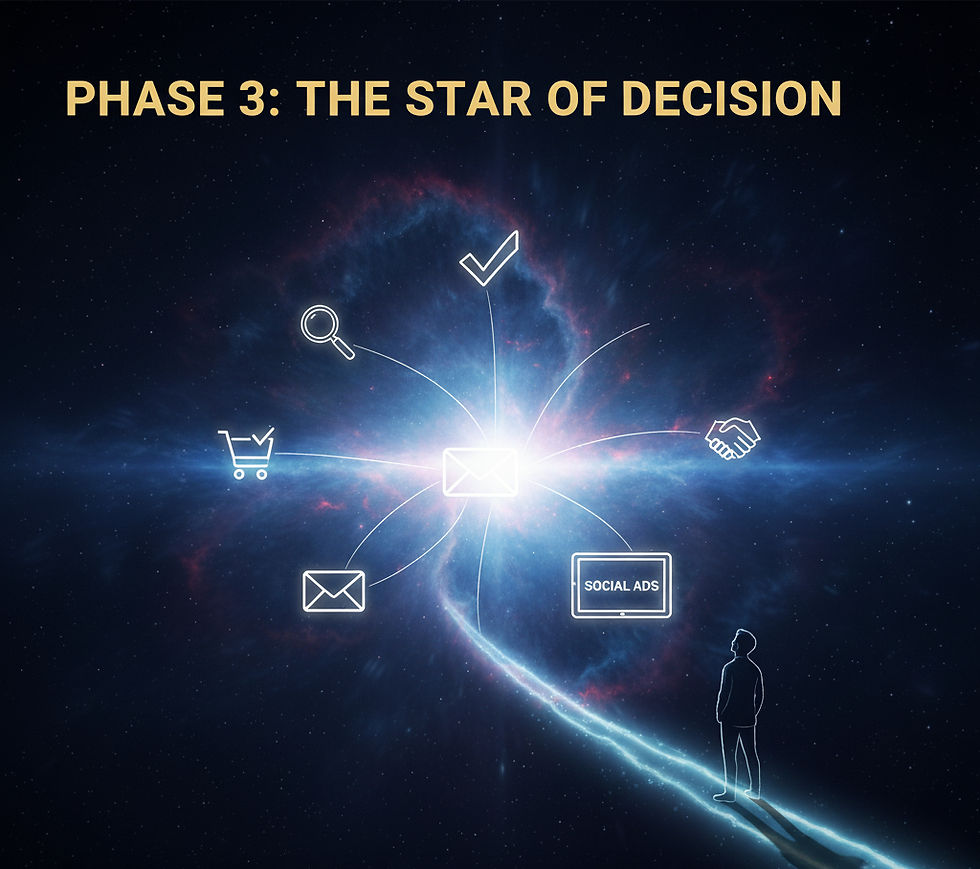Navigating the Digital Cosmos: How to Map Your Customer's Journey
- Karim El Masry
- Oct 6
- 3 min read
In the vast and ever-expanding digital cosmos, it’s easy for businesses and customers alike to feel lost. With countless websites, social platforms, and ad channels, how do you ensure your audience finds their way to you? The answer lies in creating a celestial map: a meticulously planned customer journey.
Just as ancient mariners used stars to chart their course across oceans, a well-defined customer journey map allows you to guide potential customers through the "digital night sky" directly to your brand. Without it, your marketing efforts are like launching a rocket without a trajectory – full of potential, but ultimately aimless.
So, what exactly is a customer journey map, and how do you build one that truly illuminates the path?
What is a Customer Journey Map?
At its core, a customer journey map is a visual representation of the entire process a customer goes through when interacting with your company. It covers every touchpoint, from the moment they first become aware of your brand to their post-purchase experience. It’s not just about what they do, but also what they feel and what their pain points are at each stage.
Why is This Celestial Map So Crucial?
See Through Your Customer's Eyes: It forces you to step into your customer's shoes, gaining empathy and understanding their motivations, questions, and frustrations.
Uncover Gaps and Opportunities: You can identify friction points where customers might abandon their journey or discover new opportunities to delight them.
Align Your Efforts: It ensures all your marketing, sales, and service teams are working towards a common goal, guiding the customer along the same path.
Optimize Resource Allocation: You can strategically invest in the touchpoints that have the biggest impact on conversion and satisfaction.
Charting Your Course: Key Stages of the Digital Journey
While journeys can vary, most follow a similar celestial pattern, often broken down into these core phases:
Phase 1: The Nebula of Awareness

This is where potential customers first become aware of a need or problem, and possibly your brand as a solution. They’re floating in a vast digital space, perhaps not actively looking for you, but open to discovery.
Customer Actions: Google searches for solutions, seeing social media ads, encountering a blog post, hearing word-of-mouth.
Customer Feelings: Curious, confused, indifferent, problem-aware.
Your Marketing Role: Attract attention! SEO-optimized content, social media presence, display ads, PR, influencer marketing.
Phase 2: The Constellation of Consideration

The customer now recognizes their need and is actively researching potential solutions, including yours. They are connecting the dots between various options, much like finding patterns in a constellation.
Customer Actions: Visiting your website, reading reviews, comparing products/services, signing up for a newsletter, downloading a guide, watching a demo.
Customer Feelings: Hopeful, discerning, cautious, comparing options.
Your Marketing Role: Nurture and inform! Detailed product pages, case studies, testimonials, comparison guides, webinars, email marketing.
Phase 3: The Star of Decision

This is the moment of truth: the customer decides to purchase or commit to your solution. Your brand becomes their guiding star.
Customer Actions: Making a purchase, signing up for a service, contacting sales, requesting a quote.
Customer Feelings: Eager, relieved, committed, perhaps slightly anxious.
Your Marketing Role: Facilitate the conversion! Clear calls-to-action, streamlined checkout process, excellent customer service (if applicable), compelling offers.
Phase 4: The Orbit of Retention & Advocacy

The journey doesn't end with a sale! Now, you want to keep customers orbiting your brand, turning them into loyal advocates.
Customer Actions: Using your product/service, seeking support, providing feedback, referring others, making repeat purchases.
Customer Feelings: Satisfied, valued, supported, delighted, empowered.
Your Marketing Role: Build loyalty! Post-purchase emails, customer support, loyalty programs, exclusive content, community building, asking for reviews and referrals.
How to Build Your Celestial Map: A Quick Guide
Define Your Personas: Who are you mapping for? Create detailed buyer personas representing your ideal customers.
Identify Touchpoints: Brainstorm every single interaction a customer might have with your brand, online and offline.
Outline Actions, Thoughts, & Feelings: For each stage and touchpoint, describe what the customer is doing, thinking, and feeling.
Pinpoint Pain Points & Opportunities: Where are customers getting stuck? Where can you exceed expectations?
Visualize It: Use a spreadsheet, whiteboard, or dedicated software to visually represent the journey.
Iterate & Optimize: The digital cosmos is always changing. Regularly review and update your map based on data and feedback.



Comments